Description: War Thunder is a next generation military MMO game dedicated to...

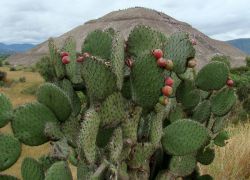
There are many stories about cacti that are as well known as the tale of Cinderella. No one remembers who and when first told this story, it is simply known to all people. Also, “everyone knows the truths” about cacti, which will be discussed, “everyone knows”. But not all of them are actually true. Many of these truths are only half true, and some are completely wrong. Let's try to understand them.
"Cactus and succulent are synonyms." Not true.
Every cactus is a succulent, but not every succulent is a cactus. Some of the succulents belong to the botanical families Liliaceae, Crassulia, Euphorbia, etc.
"Cacti grow well only in the sun." Truth.
In low-solar rooms, you can achieve flowering and growth of a cactus with a lot of effort and tricks. But their full development occurs only with large amounts of light and sun. Only some unprotected species need shelter, but they also need light. People who put their plants deep into rooms, on shelves and cabinets next to various figurines, slowly kill them.
"Cacti, like plants in hot countries, need warmth all year round." Not true.
For normal growth and flowering, cacti need a rest period. This can be achieved by keeping it cold and dry in a sunless winter time. Only moisture-loving cacti that grow in tropical forests.
"The more you look at cacti, the better they grow." Truth.
With a more frequent examination of your plants, you will be able to timely notice the impending disaster in the form of a wound, loss of roots, tick attacks, etc., and prevent it in time.
"Cacti are desert dwellers, they are afraid of water." Not true.
Not every cactus is dry-loving. But even the most dry-loving cactus during the growth period must be given enough water. They need water for nutrition and for cooling the stem by evaporation.
"The less you touch the cacti, the better." Truth.
With constant transfers and rotations, cacti lose their spines and do not bloom. This problem is most often seen in novice collectors due to the constant "dragging".
"The less often you repot cacti, the better they grow." Not true.
A properly done transplant stimulates the growth of the stem and roots. Cacti need to be repotted every year!
"Cacti don't like changing conditions." Truth.
Do not get carried away looking for non-existent "secrets". Constant changes in regime, soil, arrangements, etc. lead to deterioration or even death of the entire collection.
"In order for a cactus to bloom, it must be abundantly fertilized." Not true.
Cacti need to be fertilized, but their fertilizer needs are much less than those of leafy plants. A starving or overfed cactus will never bloom. From underfeeding, the cactus will not die, but overfeeding can be fatal for them, because they are not adapted to it according to their physiological characteristics.
"A fast-growing cactus dies easily." Truth.
Rapid growth, especially artificially induced (with growth aids), gives loose stems, poor resistance to pests and infections, and poor hairiness. Give your cactus everything it needs and let it grow at its natural rate, then you will have a normal, healthy plant.
"A cactus blooms once in a lifetime, after which it dies." Not true.
A healthy cactus blooms every summer without any harm to itself. Depletion is possible only in cases where the cactus sets too many fruits. In such cases, it is better to remove some of the berries immediately after they are tied.
"A cactus that does not start growing in summer often dies in winter." Truth.
A cactus that doesn't grow is half dead. There are, of course, exceptions that can live in such a half-dead state for several years. If you do not want to lose a non-growing cactus, then be sure to find out the reason why it stopped growing (usually this is the loss of roots) and take action. For all this, you need not be afraid of your cactus, feel free to pick them up, wash, replant and treat. A collector who is afraid of pricking himself every time will never succeed.
If you learn to love and understand cacti, they will tell you a lot more about themselves than what is told here.
Cacti are one of the most popular and beloved window houseplants. They are unusual and even mysterious. Their shapes and colors are very original. If they are provided with the appropriate conditions, then the cacti will also bloom magnificently. We are sure that in every home there is a place for these living creatures.
How to transplant cacti. It is not necessary to plant each cactus in its own flower pot; you can combine several types in one wide pot. But remember that all these varieties should be similar to each other in one thing: they require the same conditions and care.
For example, you can't plant leafy cacti such as zagocactus and thorny desert cacti together because they need different amounts of water. Also, fast growing cacti like Echinocereus will grow much faster than other varieties planted side by side. Compositions of cacti various forms and the varieties look just wonderful. Spherical cacti are placed in the foreground, column-shaped cacti in the middle. Pebbles and shells accentuate the “desert look.” Spiny cacti can only be picked up with kitchen tongs, or they can be wrapped with a piece of paper or leather. You can also wear leather gloves. In order to plant cacti, you must get soil that is deficient in nutrients, which will allow water to easily pass down; for this purpose, you can add sand or foam to the ground. But it is better, of course, to use a ready-made mixture for planting cacti.
Grafting a cactus. Grafting a cactus is the artificial splicing of a part of a stem with a rooted part of another plant. Grafting is done if it is necessary to propagate cacti that cannot grow from their own roots. Late blooming cacti also need to be grafted as this speeds up their flowering. Young plants take root very easily. Mature cacti can only be grafted if they have begun to rot. It is better to plant cacti in late May or early June, in the morning or in the evening, in gloomy weather.
Cut off the top of the plant horizontally with a blade at a distance of 8-10 cm from the base. Grab the top of the stem or sprout with a folded piece of paper. Attach the workpiece so that the sections of the adult plant and the grafted sprout coincide (they must have the same diameter). Then pull the cut with an elastic cloth. After a few weeks, the tissues of both plants will fuse.
Flowering cactus. Approximately half of all cacti begin to bloom at the age of three to four years. Cacti will bloom every year and although most cacti bloom in the spring, you may be able to assemble a collection that will please you. bright colors all year round. The secret lies in the flowers that appear only on young sprouts; thus, you must provide the necessary care in the summer and "neglect" the plants to a certain extent in the winter. Planting cacti in small flower pots encourages them to bloom.
Caring for desert cacti. In winter, the temperature should be maintained at +15 to +18 degrees, but it can be slightly lowered. Cacti grown on window sills in cool rooms should be placed in warmer rooms during a cold night. Fluffy cacti do not withstand winter temperatures below +15 degrees.
Desert cacti love light and require plenty of it, especially in winter. During hot seasons, greenhouse-grown cacti may "demand" shade.
In the spring, watering should be increased; from late spring to late summer, watering becomes less, and the water should be warmer. From the end of summer, watering should be made even less frequent, and from mid-autumn, cacti are irrigated very rarely.
In summer, in no case should you sprinkle desert cacti. They require a lot of fresh air, so keep your windows open on hot days.
Cacti should be repotted annually in the spring. Every new flower pot should only be slightly larger than the previous one.
Most desert cacti have transplantable tissues that are easily "implanted" in spring or summer. Before transplantation, the tissues are dried for several days. The spread of seeds is possible at a temperature of 17 - 25 degrees.
Forest cacti. In its natural environment- in tropical forests, these cacti grow on trees or among trees, so it is not surprising that their form and care conditions are different from the prickly desert cacti.
The only exception is the whip-shaped Aporocactus (Aporocactus flagelliformis), which grows on trees in its homeland - in Mexico, but looks like desert cacti. It is convenient to plant typical forest cacti in hanging baskets. Some types of cacti, such as ripalis, are grown for the beauty of their stems, although main feature forest cacti - their magnificent flowers.
In order for cacti to bloom every year, you must follow a few rules. You will need to provide the cacti with a cool and dry environment during their "rest" period; do not move the flower pot after the ovaries have appeared; and try to keep the cacti longer in the open air in summer months. The most beautiful cacti are Epiphyllum cacti with fragrant flowers the size of a small pot. But, unfortunately, it is very difficult to make a forest cactus bloom.
Epiphyllum should be grown on east windows. After a period of "rest" or "hibernation", when the ovaries are formed, watering should be increased. During the flowering and growth period, watering should be carried out in a normal mode, the same goes for other houseplants: increase watering when the soil becomes dry. If the tap water is too hard, you can use rainwater.
You should also spray the plant more often. Epiphyllum is an exception in this case: a small flower pot stimulates flowering, so it does not require annual replanting. Most woodland cacti have special transplant tissues that are easily grafted onto other plants. Of course, it is better to graft in the summer, cutting off the top of the stem. Before planting, the transplanted tissues are dried for several days.
Zygocactus "Decembrist"
Its branched arcuate sprouts consist of flat segments in the form of a leaf 4-5 cm; plants are usually bought with germs (ovaries). This species has many varieties. This cactus variety blooms from mid-November to late January; flowers are white, pink, red or purple. Freshly purchased plants bloom just wonderfully, but if care is not taken, the plant will soon stop blooming. These cacti during the rest period gain "strength" to bloom again; therefore, watering should be limited, the temperature should be lowered and fresh air should be allowed into the room.
Problems with cacti. The drooping end of the stem, rot spots? The reason is dry soil, especially in winter. Bad growth? The reason is insufficient watering in summer or excessive winter irrigation. Bronze spots on the skin? - Arachnoid disease. If a cork has formed on the surface of the stem, then this may be the influence of pests, a wound or hypothermia. The reason, most likely, lies in poor summer watering. Brown spots - rotting stems; this kind of problem rarely appears on well-maintained cacti.
But if this happens, then cut off the affected part, disinfect the soil with a liquid solution of carbendazim. In addition, care should become more intense during the disease period of the plant.
Cacti, or simply cacti, are perennial flowering plants. It is generally accepted that they evolved about 40 million years ago. Then Africa and South America were already separated from each other, and North America not yet connected with the South.
Despite the fact that no fossil remains of cacti of those times were found, it is believed that they first arose precisely in South America, and the northern continent came only 5-10 million years ago.
To this day, cacti in wild nature grow mainly on the American continents. It was from there that they were once transported by people and carried by birds to Europe.
However, representatives of cacti in nature can be found not only in America. Some species have been growing for a long time in the tropical part of Africa, in Ceylon and other islands of the Indian Ocean.
Where else do cacti grow: thickets of this plant can be found in Australia, the Arabian Peninsula, the Mediterranean, the Canary Islands, and Spain. Cacti grow wild in the territory of the former Soviet Union. In most cases, cacti in these places were artificially brought by man.
Basically, cacti prefer steppes, deserts and semi-deserts. Sometimes they can be found in tropical rainforests. Quite rare, but they still grow on wet coasts.
In Mexico, cacti grow in sagebrush, creosote, and also in high-altitude succulent deserts. In the high deserts, cacti are concentrated mainly on the Mexican plateau, as well as in the western and eastern parts Sierra Madre.
In what deserts cacti grow: cacti quite extensively and densely inhabit the deserts of Peru, Chile, Bolivia and Argentina.  There is a rich diversity of these plants.
There is a rich diversity of these plants.
If we indicate the geography of cactus growth by country, the list will be approximately as follows: Mexico, Brazil, Bolivia, Chile, Argentina, USA (Texas, Arizona, New Mexico), Canada, China, India, Australia, Spain, Monaco, Madagascar, Sri- lanka, Western countries Africa.
As ornamental plants, people have learned to grow cacti in open field almost everywhere, with the exception, perhaps, of the Arctic. As indoor plants, cacti have long populated the entire planet.
Cactus is a popular variety of houseplants. A flower is found in almost any home, and if we are talking about places where indoor plants are loved, cacti are present in large numbers. Home care for cacti is as simple and easy as possible.
There are 2 thousand species of plants from the cactus family, which differ:
Cacti are succulents. They store water and nutrients thanks to special tissues. They are common in places with a dry and arid climate, where precipitation is rare.
This feature is an advantage, as the ability to retain water makes maintenance easy. Among other succulents, plants such as:
Plants are easy to care for and do not require constant watering.
Another important feature of succulents is adaptability. They adapt to any conditions, are durable and do not fade, even if the owner has forgotten about them for several years, which cannot be said about croton.
Cacti do not need constant lighting or stable temperature regime. The only thing that can negatively affect the condition is the stress that results from neglect. To avoid this, follow the rules.
Caring for a flower is easy if you follow the rules that relate to creating comfortable conditions. Pay attention to:
Most succulents love light and warmth, however, this does not mean that the cactus should be kept in the sun. Periodically rearrange it in the shade, otherwise it will get burned. In the wild, cacti grow in the shade of trees or tall bushes, but there are species that are located in the sun, which does not harm them. Optimal conditions - warm temperature air. On hot days, put in the shade, and after the heat subsides, return to the light.
Adjust the amount of solar heat according to age. Keep young individuals in the sun less than adults.
Plants do not like excessive moisture. This is obvious, because cacti are adapted to hot and dry conditions. Water sparingly and make sure the soil is completely dry after watering. Checking the condition of the soil is simple - place a match or a thin stick in it. The first 3 cm should be dry. Only in this case, re-water the plant. Consider the characteristics of the soil. Sometimes dry soil repels water and does not absorb it. Use pot trays that allow you to feed the roots from below.
The greatest amount of water is needed for cacti during flowering or in the process of active growth. As a rule, growth begins in spring and continues until the end of summer. In winter and autumn, do not worry about watering, as it is not necessary.
In autumn and winter, water once every 3-4 weeks, and the amount of water should be small enough just to wet the soil. Obviously, during these seasons, the care of cacti is simplified.
Remember, using pots that don't have a drainage hole will create too much moisture for the plant and it will die.
For plants that live indoors, use 1/3 brick chips with 2/3 potting soil. If the plants live outdoors, increase the crumb ratio to 1 to 1 to create favorable conditions.
Garden stores sell soil for cacti. When choosing, consider the growing conditions and age of the cactus.
It is not necessary to use fertilizers, since growth is carried out without them. Add fertilizer to the soil, as in the case of dracaena, I recommend during periods of growth. Use houseplant fertilizers and organic fertilizers. The best option- fertilizers in granules, which have a good effect on the condition of the soil and nourish with useful substances.
Video tips
Most succulents have a shallow root system, which is important when transplanting. I advise you to transplant the cactus into a pot that differs from the previous one by the size. After transplanting, do not water the flower for several days, which will activate moisture reserves and heal the roots that have been damaged. After transplanting, I do not recommend placing the pot in direct sunlight. Increase the amount of water and sunlight gradually.
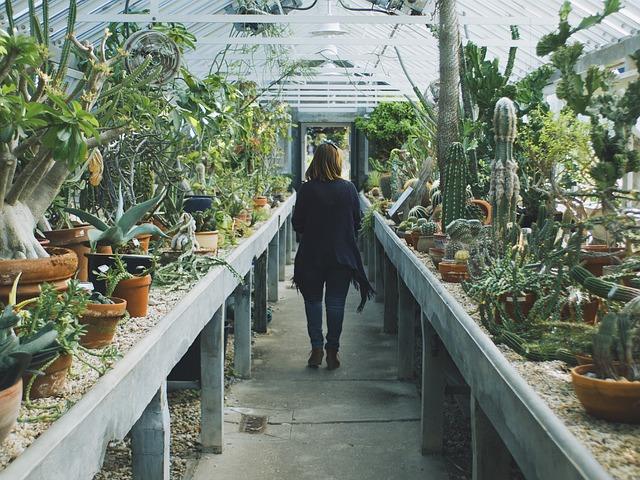
Cacti are divided into two varieties:
Representatives of both varieties can be used as houseplants, since each has unique species that will complement any home collection. Desert cacti are thorny plants that grow in dry areas. Forest cacti grow in forests in the subtropical and tropical climate. Representatives of both varieties have beautiful flowers, but differ in their growth and care.
Desert cacti are popular due to simple care and breeding. Despite the fact that many consider such a plant unpleasant and dangerous because of the thorns, I note that during flowering they become incredibly beautiful. The first flowers appear 3-4 years after planting. For some species, the deadline is sometimes delayed.
The health factor is lighting. Desert cacti need sunlight. Take good care of the lighting, and do not leave it in the sun for a long time. Gradually "harden" the plant, leaving it in the sun longer.
Cacti grow most actively at a temperature of 21 degrees and a low level of humidity. In winter, the temperature of the content drops to +13 degrees. Habitat habitat provides high temperatures during the day and quite low at night.
Watering is carried out only when the soil dries up to a depth of three centimeters from the surface. It is best to plant in special drained pots, which will improve the circulation of moisture in the soil and improve air concentration. Transplant to a new pot rarely, because the cactus grows slowly. The use of small pots speeds up flowering.
Among the common mistakes that desert cacti owners make is overwatering during the winter season. In winter, they practically do not need water, and watering is carried out in a minimal amount in order to prevent the soil and roots from drying out.
Due to excess water, the roots rot, and if the process has begun, I recommend starting growing a new plant using the shoots of the old one. In the absence of shoots, discard the cactus, because due to decay, it will not be able to grow and bloom and will die.
Forest cacti are common in tropical forests. They grow on other plants. Forest species known for their vibrant colors. In many ways, they are similar in care to desert species, however, there are differences that should be considered for breeding.
Lighting should be bright but not direct. sun rays, so in the summer, put them outdoors in a bright place, but not under direct rays.
Needed during growth low temperature, and during inactivity high temperature.
I recommend watering often, especially before flowering. During the dormant period, water as soon as the soil feels dry to the touch. Standard potting mixes are suitable as soil. Transplant before the growing season.

Popular trend to plant cacti various kinds in one pot. No wonder, because the variety of colors and shapes creates beautiful and attractive compositions.
A popular species that is known beautiful flowers and the presence of edible fruits. Species of Opuntia are low and covered with long and dense spines, the injection of which provokes unpleasant pain. Opuntia blooms with snow-white flowers, and after flowering, edible fruits of a flat, elongated shape appear.
Keep the cactus in a bright place, but during the summer heat I recommend putting it in the shade to avoid burns. Otherwise, the care requirements are the same as for other species.
The next most popular is Mammillaria. Plants have a spherical shape, pink small flowers located at the top. The spines of Mammillaria are thin and soft. There are many of them, which creates a resemblance to hairs. The species does not need special care, and the flowering period begins with early age which makes it popular. There are several species that differ in shades of flowers and spines.
The owner of the largest flowers is Echinocactus. Flowers of different shades appear in young plants. Purple flowers at the top. Plant height reaches 45 cm.
Another popular species that blooms from an early age. The sizes are small, thanks to which Gymnocalcium is convenient to store and does not take up much space. Flowers are white, red or pink.
A species with a unique structure of branches often becomes the object of attention for lovers of room exotics. The largest species in size, and in vivo protected by law. Saguaro supports the vital activity of living organisms, including birds, and therefore is considered an important plant.
A bright species that is common in tropical forests, with broad branches without thorns. In addition, it needs moisture, which is typical for all tropical plants. It blooms with bright flowers, so it is used to decorate the interior.

There can be a lot of reasons for stopping growth and falling off of a cactus (reduction in size).Incorrectly composed soil, sunburn, the cactus “dropped” its roots, the period of summer dormancy in some types of cacti, diseases, damage to the root system of the cactus by pests, etc.
One of the most common causes is problems with soil . Souring of the earth, or vice versa, alkalization, as a result of frequent watering with tap water, not boiled and not acidified water (hard with great content lime). The wrong composition of the soil mixture, which is not suitable for this particular type of cactus. Well, and the most banal reason - the cactus is already quite crowded in a pot and is not enough nutrients. So, in the absence of damage to the root system, just transplant the cactus into a fresh one. priming, if possible, taking into account the taste preferences of your cactus. For example, echinopsis prefer nutritious humus-rich lands and large pots, but astrophytum needs a poor organic, highly mineralized substrate with the addition of clay.
It happens that from a sharp temperature drop, overheating of the pot, or vice versa, severe hypothermia, the roots of the cactus die off. Moreover, they die, and do not rot. At the same time, the cactus itself remains healthy and often even able to take root without your help. But connivance in this case very risky. If you don’t know that a cactus is without roots and continue to water it intensively and, God forbid, feed it, you can simply rot it in this way.
Such cacti need to be repeated root . As a rule, small remnants of the roots remain and it is not required to “sharpen” or trim the cactus. The cactus should be placed on a light, nutritious, almost dry soil, overlaid with pebbles so that it does not fall. After three days, you can spray for the first time. momentary cactus care rooting sparing - heat, lack of direct sunlight, spray periodically. Very often, this is how the small-haired prickly pear drops its roots.
Quite common, especially in spring. In this case, the cactus is usually 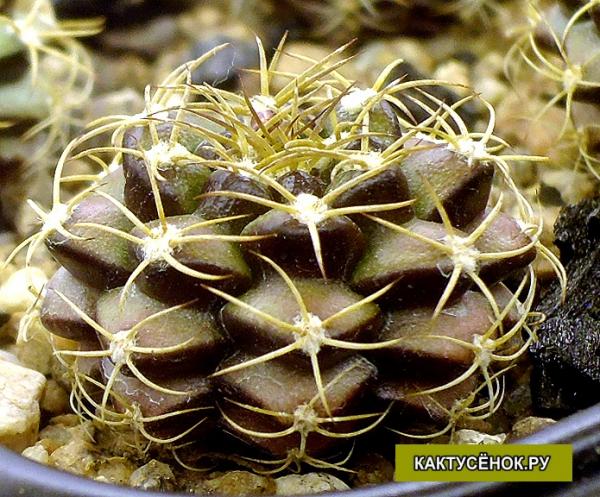 the same “falls off” and the color of the epidermis (skin) changes, which acquires a reddish-bronze hue (color variations in a tanned cactus may be different, depending on the species). Photos 1 and 3. In mild cases, after a while, the cactus received sunburn recovers healthy green color epidermis. In severe cases, spots appear up to almost white, followed by drying and necrosis of the epidermis, which remain for life and only become less over the years.
the same “falls off” and the color of the epidermis (skin) changes, which acquires a reddish-bronze hue (color variations in a tanned cactus may be different, depending on the species). Photos 1 and 3. In mild cases, after a while, the cactus received sunburn recovers healthy green color epidermis. In severe cases, spots appear up to almost white, followed by drying and necrosis of the epidermis, which remain for life and only become less over the years.  noticeable due to the growth of the cactus (photo 2). No specific treatment measures need to be applied to a burnt cactus. Remove the victim from the sun, ensure normal watering and spray periodically. To avoid sunburn, in spring, especially if you have southern windows at noon cacti first time needed shade To do this, it is enough to cover them with a napkin or simply stick a sheet of white paper on the window.
noticeable due to the growth of the cactus (photo 2). No specific treatment measures need to be applied to a burnt cactus. Remove the victim from the sun, ensure normal watering and spray periodically. To avoid sunburn, in spring, especially if you have southern windows at noon cacti first time needed shade To do this, it is enough to cover them with a napkin or simply stick a sheet of white paper on the window.
Just do not confuse, the natural color change of the cactus which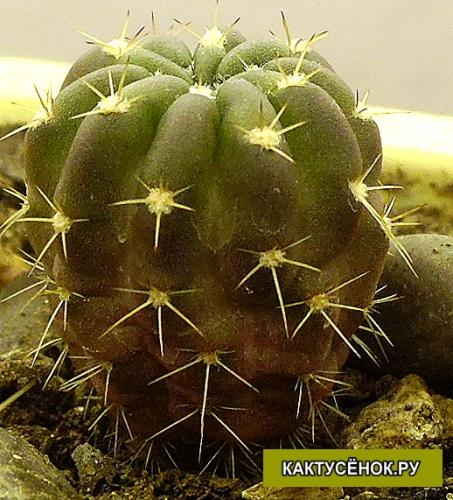 woke up and was about to grow up with burns. This is how some mammillaria behave, turning crimson-pink at the bottom of the stem in early spring, thus informing the cactus grower that it would be time to water already.
woke up and was about to grow up with burns. This is how some mammillaria behave, turning crimson-pink at the bottom of the stem in early spring, thus informing the cactus grower that it would be time to water already.
As it is not surprising, but even a cactus accustomed to the sun can get a serious burn. Moreover, in the middle of the summer season. This phenomenon is relatively rare, and "naked" cacti, with low spininess, and absent pubescence, are primarily susceptible to such burns. Before you is a young underground parody (Parodia subterranea). The cactus got burned at the end of July, after it was turned 180 degrees for the first time in the whole season. It was hot and the sun was beating down mercilessly. The result, so to speak, on the "face". Such burns on cacti do not disappear without a trace. The second photo was taken about a couple of months later. The color of the epidermis was slightly restored on the upper areolas, but a crust of dead tissue formed in the center.
The moral of this fable is this - a cactus accustomed to the sun is a relative concept. If you lay on the beach all day with your back exposed to the sun, this does not mean that when you roll over, your chest and stomach will not burn :-).
In window sill culture, cacti often have to be rotated in order to grow evenly, as even in the sunniest windows, they lean towards the light source. Don't do this on very hot days. sunny days so that the cactus does not get burned.
In the photo on the left, another example of cactus problems associated with 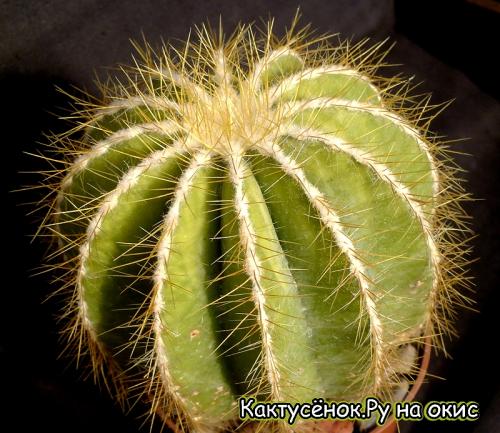 sun and heat. This is not a burn, it's just that the eriocactus is hot and lacks moisture (when this photo was taken, it was hot and the temperature in the greenhouse reached 35 - 40 degrees). The epidermis became light, lost its luster, became slightly wrinkled and even small dents are more visible. light color. Such a cactus needs to be watered urgently and temporarily removed from bright sun
, spraying the same will not hurt.
sun and heat. This is not a burn, it's just that the eriocactus is hot and lacks moisture (when this photo was taken, it was hot and the temperature in the greenhouse reached 35 - 40 degrees). The epidermis became light, lost its luster, became slightly wrinkled and even small dents are more visible. light color. Such a cactus needs to be watered urgently and temporarily removed from bright sun
, spraying the same will not hurt.
Another reason for stopping the growth of a cactus can be purely physiological - the cactus falls into a state of stagnation under unfavorable conditions for it. Even if you have created ideal conditions for the cactus from your point of view, this does not mean that his it suits. July, sun, water, +27 degrees, what else does a cactus need for happiness and normal growth? And your reboutia has all shrunk, shrank and does not want to grow into anything ... It's very simple - the rebutia is sleeping, because it's hot! In nature, it grows high in the mountains, where there is no such temperature, which means that these are unfavorable conditions for it. Attempts to make it grow by increased watering can end in failure. On the contrary, it is necessary to reduce watering for the period of summer dormancy in those types of cacti that need it. These include rebusias, lobivias, ilosters, some parodies, and even certain types gymnacoliciums. For exampleand Bruch's Gymnocalycium (Gymnocalycium bruchii), both dislike heat and stagnate in mid-summer.
Interesting and peculiar representatives of the genus, too may show stagnation in summer, but according to my observations, more often, this is due to insufficient watering. It is worth "missing" the frailey and she strives to fall asleep for the whole summer. Unlike representatives of the mountain cacti described above, these cacti need to be awakened by force, with abundant watering and, because otherwise they may die. I have listed far from all types of cacti that need summer rest .. Watching the cacti from your collection, you yourself can replenish the list of "summer dormouse" for yourself.
Dangerous in the first place, its "invisibility". If the rest of the cactus pests can be found during an external examination of the cactus, then this reptile lives in the ground and its presence in your collection may not be pleasant surprise, already on the fact of the "dirty deeds" he had committed or accidentally during the transplant. root bug is able to migrate from pot to pot in search of a better life, so that the cacti standing around the infected specimen are also in danger.
There are several ways to deal with this pest of cacti - chemical and mechanical. In the first case, the cactus is sprayed and shed with a solution of a systemic insecticide, for example "A ktara”, followed by repeatedprocessing after 10 - 14 days, in order to exclude the appearance of freshly hatched pest eggs. In the second version, the cactus is given a "bath day", washing the roots and even the cactus itself under a strong stream of water and additionally withstand in a container with hot water (50 - 60 gr.) for about 10 - 15 minutes. After that, the cactus is dried for several days and planted in sterile soil. Sometimes both of these methods are combined.
In other cases, when nests are found, they must be exterminated by collecting them with a cotton swab dipped in alcohol, if there are not many pests, they can also be collected mechanically. In addition, it is desirable to carry out processing by system and insecticide . One of the most effective drugs to fight mealybug is Aktara.
As with cactus diseases, the presence of cactus pests is easier to prevent with preventive treatments. I carry out such treatments for all, without exception, cacti in my collection 2-3 times a year - spraying and obligatory strait 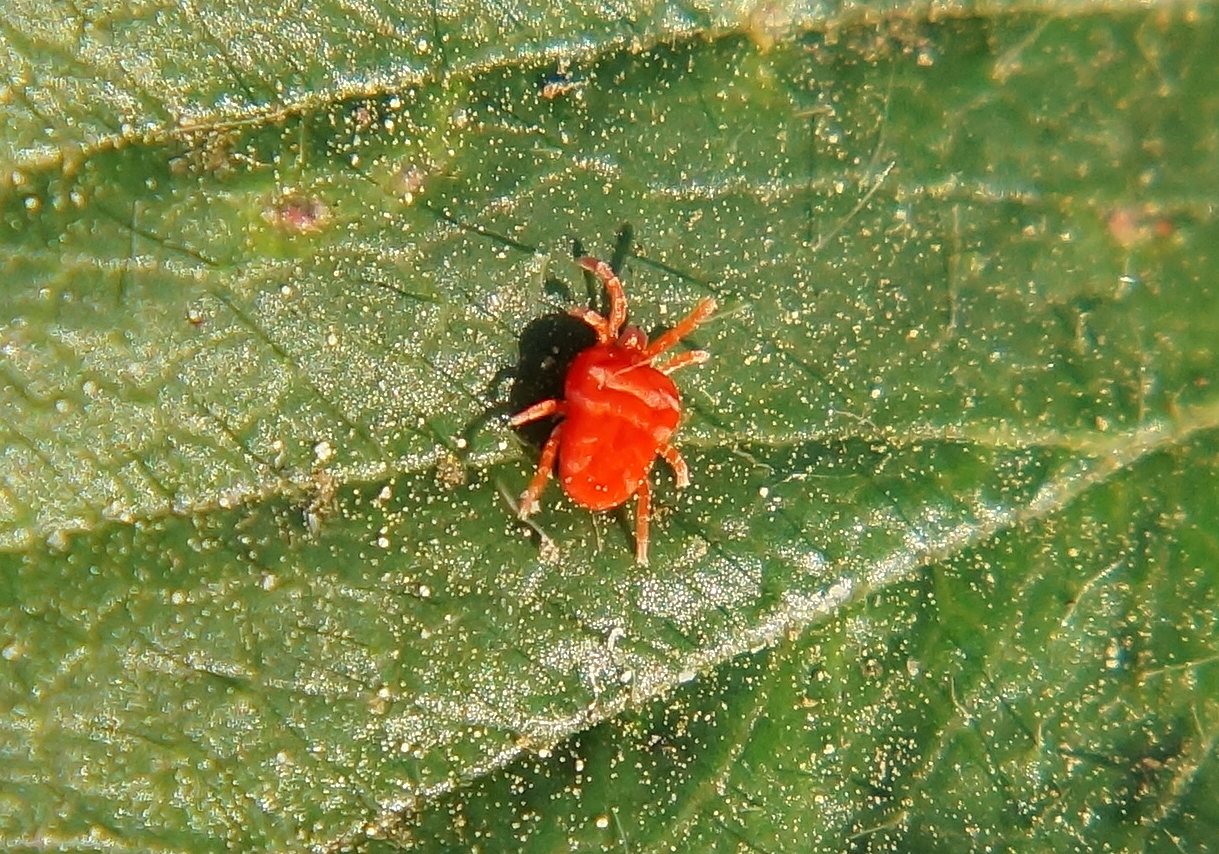 soil before wintering.
soil before wintering.
Well, of course, quarantine is necessary for new cacti, soil sterility and
transplantation of imported specimens,at least sincepurpose of checking the roots for the presence of the same root scale insect to find him before he attacks your home cacti. For your information - all of the above pests are "special  are studied "not only on cacti, their appetite is huge, and their taste preferences are very extensive. So, theoretically, the source of infection can be any indoor plant
. In fairness, it should be noted that there are pleasant exceptions, such as this harmless spider - jumper,
which the hand does not rise to be classified as pests ..
are studied "not only on cacti, their appetite is huge, and their taste preferences are very extensive. So, theoretically, the source of infection can be any indoor plant
. In fairness, it should be noted that there are pleasant exceptions, such as this harmless spider - jumper,
which the hand does not rise to be classified as pests ..
Articles about cacti >>
-------------WHEN USING MATERIALS, A LINK TO THE SITE IS MANDATORY!!---------- HERE YOU CAN LEAVE YOUR COMMENTS